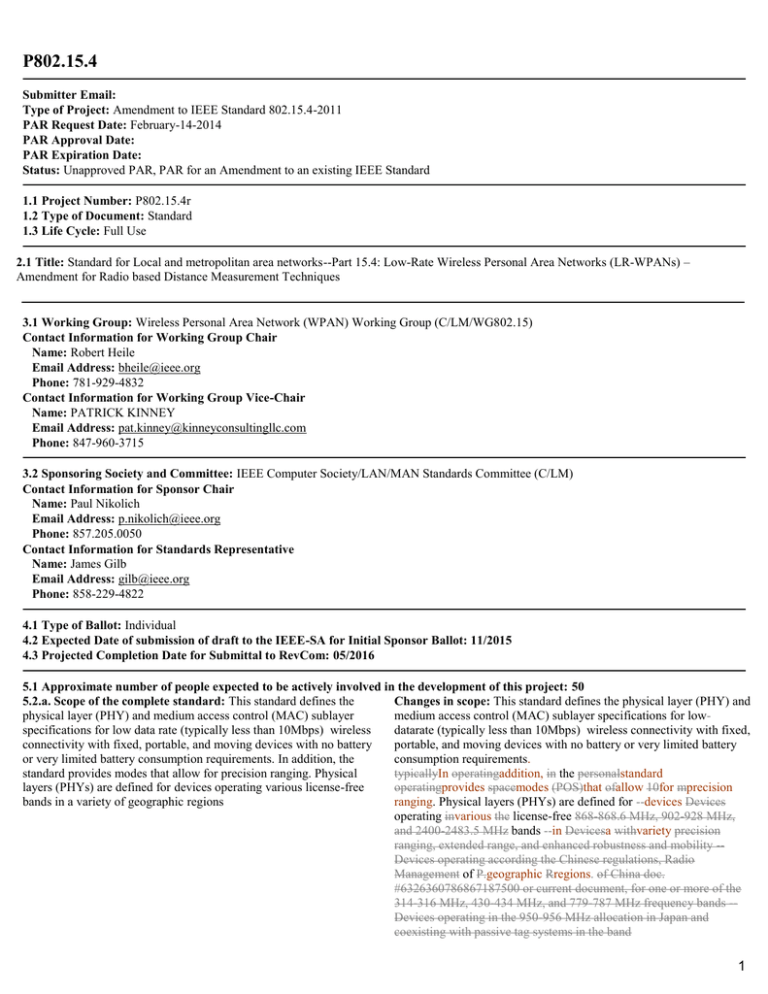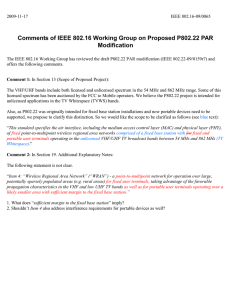P802.15.4
advertisement

P802.15.4 Submitter Email: Type of Project: Amendment to IEEE Standard 802.15.4-2011 PAR Request Date: February-14-2014 PAR Approval Date: PAR Expiration Date: Status: Unapproved PAR, PAR for an Amendment to an existing IEEE Standard 1.1 Project Number: P802.15.4r 1.2 Type of Document: Standard 1.3 Life Cycle: Full Use 2.1 Title: Standard for Local and metropolitan area networks--Part 15.4: Low-Rate Wireless Personal Area Networks (LR-WPANs) – Amendment for Radio based Distance Measurement Techniques 3.1 Working Group: Wireless Personal Area Network (WPAN) Working Group (C/LM/WG802.15) Contact Information for Working Group Chair Name: Robert Heile Email Address: bheile@ieee.org Phone: 781-929-4832 Contact Information for Working Group Vice-Chair Name: PATRICK KINNEY Email Address: pat.kinney@kinneyconsultingllc.com Phone: 847-960-3715 3.2 Sponsoring Society and Committee: IEEE Computer Society/LAN/MAN Standards Committee (C/LM) Contact Information for Sponsor Chair Name: Paul Nikolich Email Address: p.nikolich@ieee.org Phone: 857.205.0050 Contact Information for Standards Representative Name: James Gilb Email Address: gilb@ieee.org Phone: 858-229-4822 4.1 Type of Ballot: Individual 4.2 Expected Date of submission of draft to the IEEE-SA for Initial Sponsor Ballot: 11/2015 4.3 Projected Completion Date for Submittal to RevCom: 05/2016 5.1 Approximate number of people expected to be actively involved in the development of this project: 50 5.2.a. Scope of the complete standard: This standard defines the Changes in scope: This standard defines the physical layer (PHY) and physical layer (PHY) and medium access control (MAC) sublayer medium access control (MAC) sublayer specifications for lowspecifications for low data rate (typically less than 10Mbps) wireless datarate (typically less than 10Mbps) wireless connectivity with fixed, connectivity with fixed, portable, and moving devices with no battery portable, and moving devices with no battery or very limited battery or very limited battery consumption requirements. In addition, the consumption requirements. standard provides modes that allow for precision ranging. Physical typicallyIn operatingaddition, in the personalstandard layers (PHYs) are defined for devices operating various license-free operatingprovides spacemodes (POS)that ofallow 10for mprecision bands in a variety of geographic regions ranging. Physical layers (PHYs) are defined for --devices Devices operating invarious the license-free 868-868.6 MHz, 902-928 MHz, and 2400-2483.5 MHz bands --in Devicesa withvariety precision ranging, extended range, and enhanced robustness and mobility -Devices operating according the Chinese regulations, Radio Management of P.geographic Rregions. of China doc. #6326360786867187500 or current document, for one or more of the 314-316 MHz, 430-434 MHz, and 779-787 MHz frequency bands -Devices operating in the 950-956 MHz allocation in Japan and coexisting with passive tag systems in the band 1 5.2.b. Scope of the project: This amendment integrates wireless ranging techniques and technologies, including those existing within IEEE 802.15.4 and new to IEEE 802.15.4, into a consistent, standardized method addressing the needs of a wide range of applications and PHYs and enabling the interoperability of devices by different vendors using this method. Additionally, the amendment defines necessary MAC and PHY extensions which enable common radio based distance measurements. 5.3 Is the completion of this standard dependent upon the completion of another standard: No Changes in purpose: The standard provides for ultra low complexity, 5.4 Purpose: This document will not include a purpose clause. ultra low cost, ultra low power consumption, and low data rate wireless connectivity among inexpensive devices. The raw data rate is high enough (250 kb/s) to satisfy a set of applications but is also scaleable down to the needs of sensor and automation needs (20 kb/s or below) for wireless communications. In addition, one of the alternate PHYs provides precision ranging capability that is accurate to one meter. Multiple PHYs are defined to support a variety of frequency bands including -- 868-868.6 MHz -- 902-928 MHz -- 2400-2483.5 MHz -314-316 MHz, 430-434 MHz, and 779-787 MHz band for LR-WPAN systems in China -- 950-956 MHz in Japan. 5.5 Need for the Project: The IEEE 802.15.4 standard addresses many markets where there is a substantial need for both communications and determination of distances between two devices, i.e. ranging. The following is a representative set of application examples: covering a variety of accuracies, from centimeters to many 10s of meters: - a retailer needs to determine the proximity of a shopper to specific points/displays and then send the appropriate data - a medical environment needs to determine the proximity of a staff person to a desired item and inform that staff as to specific data for that item - lighting control networks need to determine the range between devices to facilitate binding for control, e.g. a specific switch to a specific light fixture - TV whitespace networks require location awareness via accurate ranging from multiple devices to determine available frequency bands - Railroad services desire the ability for a locomotive to determine the distance to various devices for identification, etc. Given that various regions and applications are served by numerous frequency bands following different regulatory rules, modulations, and data rates; complexity and confusion can only be avoided if ranging data is made available to higher layers in a consistent manner for location determination mechanisms. Hence there is a need for an Real Time Locating System (RTLS) RTLS which works with the diverse PHYs of IEEE 802.15.4. 5.6 - Stakeholders for the Standard: The Stakeholders include: Communication device manufacturers and users Infrastructure operators Device component and systems suppliers Industrial Automation providers Building Automation providers Intelligent Traffic System Providers Large Scale Monitoring for Safety providers Intellectual Property 6.1.a. Is the Sponsor aware of any copyright permissions needed for this project?: No 6.1.b. Is the Sponsor aware of possible registration activity related to this project?: No 7.1 Are there other standards or projects with a similar scope?: No 7.2 Joint Development Is it the intent to develop this document jointly with another organization?: No 8.1 Additional Explanatory Notes (Item Number and Explanation): 2


